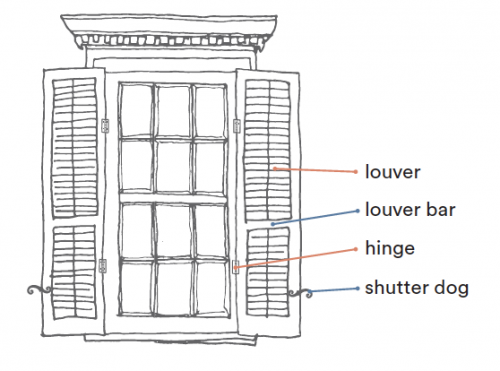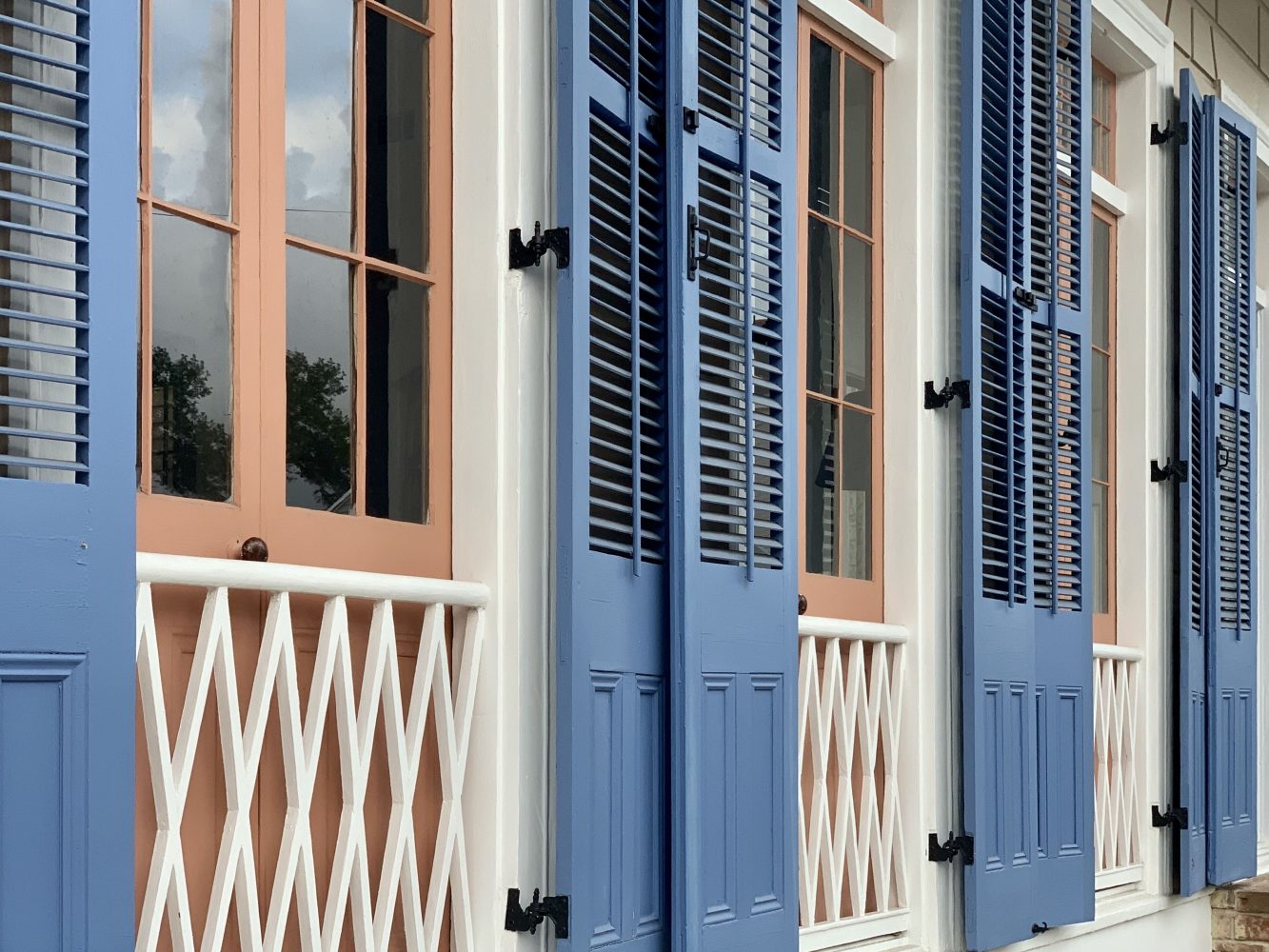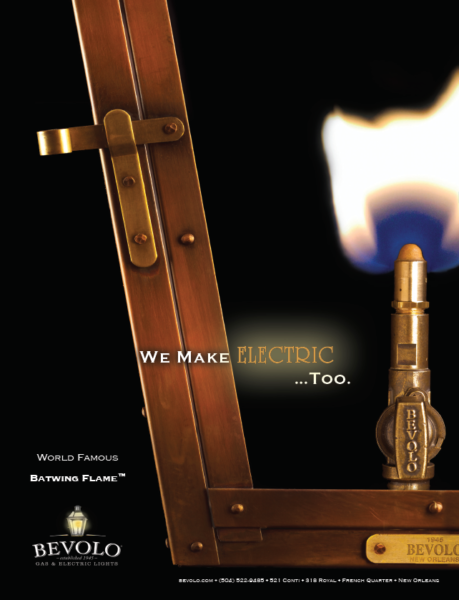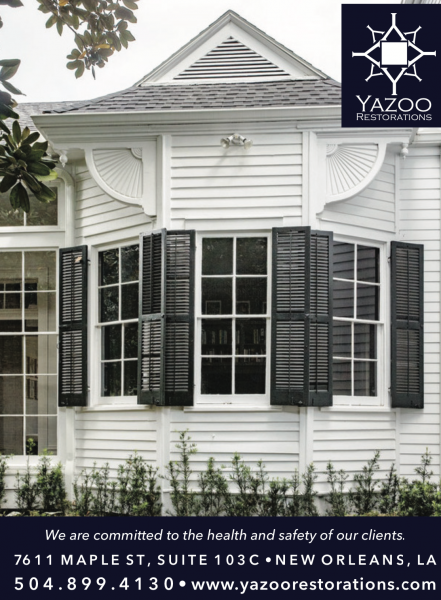This story appeared in the June issue of PRC’s Preservation in Print magazine. Interested in getting more preservation stories like this delivered to your door nine times a year? Become a member of the PRC for a subscription!
As you prepare your house for hurricane season, don’t forget to check the condition of your functional wooden shutters. Now is the time to make repairs, if needed.
In proper working condition, functional shutters are as practical as they are charming. They help protect your home from the elements, dampen street noise, provide privacy and filter out sunlight, reducing heating and cooling costs. If your home is missing historically accurate shutters, you can find vintage options at architectural salvage stores, such as The Bank Architectural Antiques and Ricca’s Architectural Sales. Or you could have custom shutters made at a mill shop.
Matthew Thompson, owner of Silvarum LLC, a woodworking shop in the Bywater that specializes in repairing and recreating historically appropriate architectural elements and custom furniture designs, offered the following tips for assessing the condition of existing shutters and things to consider when ordering new shutters for a historic house.
But, first, if your home is located in a local historic district, make sure to apply for a Certificate of Appropriateness from the New Orleans Historic District Landmarks Commission prior to doing any work on the exterior. To find out if your house is in a historic district and to view the HDLC guidelines, visit nola.gov/hdlc/design-guidelines.

Photo and illustration by Liz Jurey
ASSESSING EXISTING SHUTTERS
Make certain you have the correct number of shutters: It may sound obvious, but shutters should come in pairs. Pieces may have gone missing over the years. Thompson and his team often find missing shutters under houses or in attics. “You’d be surprised how many houses have odd shutters negligently stored in these places by former owners,” he said.
Check the hardware: Can you securely lock the shutters? Can you secure them in an open position? Look for the presence of the slide bolts and upper and lower door bolts, as well as the “shutter dogs” or shutter hooks, which typically are iron pieces that hold the shutters in the open position. Are the hooks frozen from rust or paint?
Inspect the hinges: Make certain that each set of shutters has all of its hinges and that they are the same type of hinge. Shutter hinges come in several different types, including lift-off hinges (also known as pin hinges), Acme Mortise hinges, strap hinges and barrel hinges. Each of these hinges comes in various sizes to hold shutters of different sizes and weights.
Advertisement
Close the shutters: Open and close your shutters to make certain they work properly. They should neatly close over the window, usually overlapping, with a smooth, clean action. If they do not open or close, look for common problems. Are the shutters screwed or nailed open or shut? Is one of the hinges rusty, frozen, broken or missing? Are they mounted too far within the window frame and bottoming out against the window stop? Are they experiencing “hinge bind” from being mounted too close to the jamb?
Check the louver bar: Is it is connected to the louvers? If not, use a staple gun and ¾-inch staples to reattach the louvers. Also, are all of the louvers present? Missing louvers can be milled at a local mill shop and attached. Most louvered shutters are not standard sizes, so individual louvers will have to be custom made. “If you’re having them milled,” Thompson said, “it would be sensible to mill more than you need, just so you have them to replace future, missing louvers.”
Check for rot: Examine the rails and stiles, as well as the wood panels (if they have a panel). Most wooden shutters can be repaired in whole or in part. However, the repair of its main elements — rails and stiles — will require that the shutter be “sprung” completely apart and put back together, Thompson said. “This can get expensive, depending upon how large the shutter might be,” he said. “Be certain to get a price quote (per shutter) for this work, as it might be cheaper to have a new shutter milled.”
All of these problems — missing hinges, frozen shutters, mismatched hardware — can be addressed by a skilled carpenter, armed with a good toolbox, a hand planer, a router, a skill saw and a working, practical knowledge of physics, Thompson said.
IF YOU NEED NEW SHUTTERS
Before you order new shutters, be sure to get approval from the HDLC if your home is located within a local historic district. There are different types of shutters — Bahama, operable louvered shutters, fixed louvered shutters and batten shutters — and you’ll need to find out which type is appropriate for the age and style of your home.
“All louvered shutters are rather fragile by nature and design,” Thompson said. “The louvers tend to break, split or fall out over time, although they are very attractive and useful for airflow and light.” Usually, fixed louvered shutters are hardier than operable louvered shutters and cheaper, too, because the labor in making the louvers operable is significantly more.
Whether you need a single shutter replacement or a full house of shutters, get a fixed quote (per opening) from a local mill shop, Thompson advises. “Make certain that the millworker comes out and measures your window and door openings in person and express to him what type of shutter you want,” he said. “Also, whenever possible, make certain that the millworker is installing your shutters, too. As a rule, most custom work should be installed by the custom shop that you’ve hired. It tends to ensure that they’ll be more careful with making it to a sensible, workable size.”
Do not agree to pay full price up front, Thompson said. Most shops will accept half payment up front and the rest upon completion of the job, he said, “although it is probably safer to break the payment into three payments — at the beginning, on delivery and on completion of the install.”
“Be sure to check all of the work before the millworker leaves,” Thompson said. “Do the shutters open and close cleanly? Is the correct hardware on the shutter to secure it? Is there a lock on a shutter door? Is there a mail slot on a front shutter door (if one is needed)?”
Thompson recommends milling new shutters from Spanish Cedar or Sapelo, both woods that are generally long lasting, water resistant and affordable. “Honduran or African Mahogany, although very durable, tend to be overkill on a job like this (and can add to the cost),” he said. “Also, make certain that the shutters are pinned through their joints so there isn’t any slippage or separating of the joint. Shutters take a real beating in New Orleans weather, so they need every element in place to remain hardy.”
New shutters should arrive painted with a primer coat, two base coats and a finish coat applied after they’ve been installed. “It’s advisable not to order your louvered shutters unpainted on the assumption that you will paint them,” Thompson said. “Painting between the louvers is ridiculously tedious and difficult. Most shops will paint the louvers before they’re installed in the shutter, and, too, paint the inside edges of the frame, assemble the frame and louvers, and spray the shutter twice before delivery. After installed on the house, they should be touched up once again.”
Susan Langenhennig is PRC’s Director of Communications and the editor of Preservation in Print.
Advertisements










